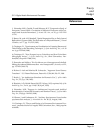
Lexicon
Page 50
Theory
and
Design
sound does not. Occasional extra wide sound effects can seem peculiar at
first for being so much wider than the screen but when the mix is good the
emotional impact of the wide sound can be very great. The disparity
between the size of the video screen and the size of the sound is usually easy
to accept, and the added impact is hard to give up once you have heard it.
A few theaters are beginning to wake up to the power of this effect. It is being
used presently and has been used in the past. Some theaters, such as Imax
and Omnimax, use it routinely with multi-track masters, and older tech-
niques such as Todd-AO had wonderful multichannel soundsystems.
The major reason standard theaters do not use this is the poor accuracy of
previous surround decoders when used with commercially available stereo
prints. Azimuth errors on both optical and magnetic masters are common
and in theaters there can often be considerable dialog leakage into the left
and right channels. To increase the seating area with acceptable dialog,
theaters place the left and right speakers within the confines of the screen.
The needed spatial impression is supplied by the acoustics of the theater
itself, augmented by surround speakers placed all around the audience. The
surround speakers are driven in parallel from the surround channel output
of the decoder.
The CP-1 can be used to create a similar set-up in the home by connecting
the side speakers to the rear amplifiers. However, our experiments indicate
that most people find this far from optimal. The use of auto azimuth, auto
balance and digital steering make the CP-1 superior to any other surround
decoder, including the professional decoder for theaters. This allows us to
remove the dialog completely and feed the left and right signals (not the
surround) to the side speakers. When side speakers are present this is a
marvelous solution. (See speaker configurations 10 and 11, page 13.) Much
the same effect as separate side loudspeakers can be provided by simply
placing the main loudspeakers near the sides of the listeners and using the
center loudspeaker to fill in the middle of the front image.


















